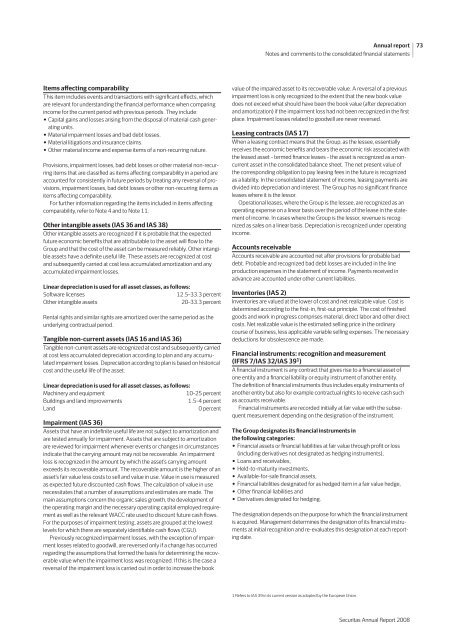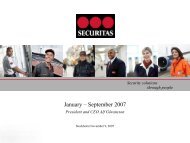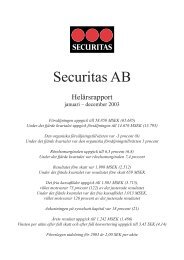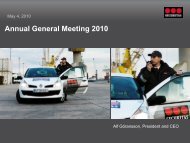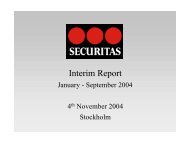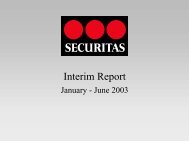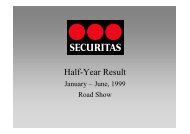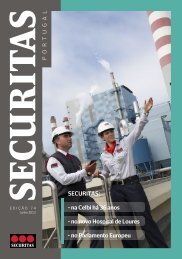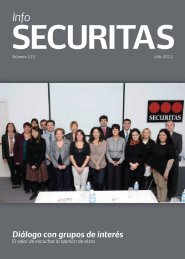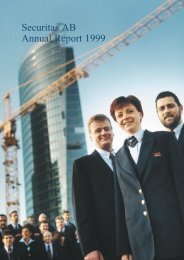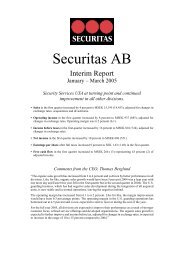Annual Report 2008 - Securitas
Annual Report 2008 - Securitas
Annual Report 2008 - Securitas
Create successful ePaper yourself
Turn your PDF publications into a flip-book with our unique Google optimized e-Paper software.
Items affecting comparability<br />
This item includes events and transactions with significant effects, which<br />
are relevant for understanding the financial performance when comparing<br />
income for the current period with previous periods. They include:<br />
• capital gains and losses arising from the disposal of material cash generating<br />
units.<br />
• Material impairment losses and bad debt losses.<br />
• Material litigations and insurance claims.<br />
• Other material income and expense items of a non-recurring nature.<br />
Provisions, impairment losses, bad debt losses or other material non-recurring<br />
items that are classified as items affecting comparability in a period are<br />
accounted for consistently in future periods by treating any reversal of provisions,<br />
impairment losses, bad debt losses or other non-recurring items as<br />
items affecting comparability.<br />
For further information regarding the items included in items affecting<br />
comparability, refer to Note 4 and to Note 11.<br />
Other intangible assets (IAS 36 and IAS 38)<br />
Other intangible assets are recognized if it is probable that the expected<br />
future economic benefits that are attributable to the asset will flow to the<br />
Group and that the cost of the asset can be measured reliably. Other intangible<br />
assets have a definite useful life. These assets are recognized at cost<br />
and subsequently carried at cost less accumulated amortization and any<br />
accumulated impairment losses.<br />
Linear depreciation is used for all asset classes, as follows:<br />
Software licenses 12.5–33.3 percent<br />
Other intangible assets 20–33.3 percent<br />
Rental rights and similar rights are amortized over the same period as the<br />
underlying contractual period.<br />
Tangible non-current assets (IAS 16 and IAS 36)<br />
Tangible non-current assets are recognized at cost and subsequently carried<br />
at cost less accumulated depreciation according to plan and any accumulated<br />
impairment losses. Depreciation according to plan is based on historical<br />
cost and the useful life of the asset.<br />
Linear depreciation is used for all asset classes, as follows:<br />
Machinery and equipment 10–25 percent<br />
Buildings and land improvements 1.5–4 percent<br />
Land 0 percent<br />
Impairment (IAS 36)<br />
Assets that have an indefinite useful life are not subject to amortization and<br />
are tested annually for impairment. Assets that are subject to amortization<br />
are reviewed for impairment whenever events or changes in circumstances<br />
indicate that the carrying amount may not be recoverable. An impairment<br />
loss is recognized in the amount by which the asset’s carrying amount<br />
exceeds its recoverable amount. The recoverable amount is the higher of an<br />
asset’s fair value less costs to sell and value in use. value in use is measured<br />
as expected future discounted cash flows. The calculation of value in use<br />
necessitates that a number of assumptions and estimates are made. The<br />
main assumptions concern the organic sales growth, the development of<br />
the operating margin and the necessary operating capital employed requirement<br />
as well as the relevant WACC rate used to discount future cash flows.<br />
For the purposes of impairment testing, assets are grouped at the lowest<br />
levels for which there are separately identifiable cash flows (CGU).<br />
Previously recognized impairment losses, with the exception of impairment<br />
losses related to goodwill, are reversed only if a change has occurred<br />
regarding the assumptions that formed the basis for determining the recoverable<br />
value when the impairment loss was recognized. If this is the case a<br />
reversal of the impairment loss is carried out in order to increase the book<br />
value of the impaired asset to its recoverable value. A reversal of a previous<br />
impairment loss is only recognized to the extent that the new book value<br />
does not exceed what should have been the book value (after depreciation<br />
and amortization) if the impairment loss had not been recognized in the first<br />
place. Impairment losses related to goodwill are never reversed.<br />
Leasing contracts (IAS 17)<br />
when a leasing contract means that the Group, as the lessee, essentially<br />
receives the economic benefits and bears the economic risk associated with<br />
the leased asset – termed finance leases – the asset is recognized as a noncurrent<br />
asset in the consolidated balance sheet. The net present value of<br />
the corresponding obligation to pay leasing fees in the future is recognized<br />
as a liability. In the consolidated statement of income, leasing payments are<br />
divided into depreciation and interest. The Group has no significant finance<br />
leases where it is the lessor.<br />
Operational leases, where the Group is the lessee, are recognized as an<br />
operating expense on a linear basis over the period of the lease in the statement<br />
of income. In cases where the Group is the lessor, revenue is recognized<br />
as sales on a linear basis. Depreciation is recognized under operating<br />
income.<br />
Accounts receivable<br />
Accounts receivable are accounted net after provisions for probable bad<br />
debt. Probable and recognized bad debt losses are included in the line<br />
production expenses in the statement of income. Payments received in<br />
advance are accounted under other current liabilities.<br />
Inventories (IAS 2)<br />
Inventories are valued at the lower of cost and net realizable value. Cost is<br />
determined according to the first-in, first-out principle. The cost of finished<br />
goods and work in progress comprises material, direct labor and other direct<br />
costs. Net realizable value is the estimated selling price in the ordinary<br />
course of business, less applicable variable selling expenses. The necessary<br />
deductions for obsolescence are made.<br />
Financial instruments: recognition and measurement<br />
(IFRS 7/IAS 32/IAS 39 1 )<br />
A financial instrument is any contract that gives rise to a financial asset of<br />
one entity and a financial liability or equity instrument of another entity.<br />
The definition of financial instruments thus includes equity instruments of<br />
another entity but also for example contractual rights to receive cash such<br />
as accounts receivable.<br />
Financial instruments are recorded initially at fair value with the subsequent<br />
measurement depending on the designation of the instrument.<br />
The Group designates its financial instruments in<br />
the following categories:<br />
• Financial assets or financial liabilities at fair value through profit or loss<br />
(including derivatives not designated as hedging instruments),<br />
• Loans and receivables,<br />
• Held-to-maturity investments,<br />
• Available-for-sale financial assets,<br />
• Financial liabilities designated for as hedged item in a fair value hedge,<br />
• Other financial liabilities and<br />
• Derivatives designated for hedging.<br />
The designation depends on the purpose for which the financial instrument<br />
is acquired. Management determines the designation of its financial instruments<br />
at initial recognition and re-evaluates this designation at each reporting<br />
date.<br />
1 refers to IAS 39 in its current version as adopted by the European Union.<br />
<strong>Annual</strong> report<br />
Notes and comments to the consolidated financial statements<br />
<strong>Securitas</strong> <strong>Annual</strong> report <strong>2008</strong><br />
73


